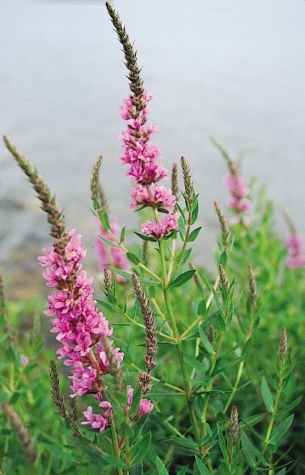Gardening isn't all about plants. As environmental awareness increases, more and more people are finding ways to "green" up the garden. There are lots of ways to make the garden more environmentally friendly, ranging from complex projects to simple things that can actually save you money.
 Rain barrels are a great way to reduce water usage. Rain barrels sit under the downspout of roof gutters to collect rainwater from the roof. We don't have a rain barrel in the garden since we don't have any shelters with gutters, but they are definitely a great option for the home garden. Most home improvement and garden stores carry rain barrels, with prices ranging from $60 to $150.
Rain barrels are a great way to reduce water usage. Rain barrels sit under the downspout of roof gutters to collect rainwater from the roof. We don't have a rain barrel in the garden since we don't have any shelters with gutters, but they are definitely a great option for the home garden. Most home improvement and garden stores carry rain barrels, with prices ranging from $60 to $150.Making your own rain barrel is also an option if you can get your hands on a barrel. It's usually easy to find 30 gallon plastic barrels on craigslist. Make sure that they were not used to store any harsh chemicals. Barrels used in food manufacturing work well. Hardware stores sell spigots to add to the barrel. Putting a screen on top is a good idea, as this will keep debris from clogging up the barrel.
Whether you buy or make your rain barrel, water pressure needs to be high for a hose to be attached and functional. This can be achieved two ways: a pump or elevation. A raised platform will provide enough water pressure to be able to use a hose. Otherwise, an electric pump ($60+) will create needed pressure, enough to power a sprinkler or a soaker hose.
 Composting will help you add organic matter back to your soil and also keep garden waste out of landfills. Composters can be purchased or built pretty easily. Prices on composters range from $60-$200 depending on the style on size. Most manufactured composters are barrels with a crank that allow gardeners to turn the compost easily. Turning compost speeds the breakdown process and produces better compost.
Composting will help you add organic matter back to your soil and also keep garden waste out of landfills. Composters can be purchased or built pretty easily. Prices on composters range from $60-$200 depending on the style on size. Most manufactured composters are barrels with a crank that allow gardeners to turn the compost easily. Turning compost speeds the breakdown process and produces better compost. Homemade bins can be complex or simple. The easiest way to build your own compost bin is with pallets. Pallets can be found easily for free. Simply take three pallets, arrange them in a square with one side missing, and nail them together. Leaving the front open will make it easy to turn the compost with a pitchfork. More complex compost bins can be made with three separate compartments, allowing for multiple loads of compost to be processing at once at different stages.
Knowing some best practices for composting is important. Compost piles need air, water, and nutrients for optimum performance. When rain water is not keeping your pile sufficiently moist, watering the pile is important to encourage microbial activity and speed breakdown. Different materials have different carbon:nitrogen ratios. To provide the best ratio (30C:1N) pay attention to the things you are adding. Green stuff (grass clippings, manure) is high in nitrogen, while browns (sawdust, dried leaves) are higher in carbon. If the ration of C:N is too high, nitrogen fertilizer can be added to fix the ratio. Turn the pile 1-2 per month to speed decomposition. For more details on composting, check out the University's Extension website: http://www.extension.umn.edu/distribution/horticulture/DG3296.html
 Wise plant selection is another way to minimize your environmental impact in the garden. Native plants are usually better adapted to the climate you live in and will likely require less inputs than non-native plants. Knowing the micro-environment of the location you will be planting in can help in plant selection. Finding out the soil type, drainage and water availability, and light in the area of the garden and selecting plants that are well adapted to those conditions will mean a healthier plant, less work for you, and a lessened environmental impact.
Wise plant selection is another way to minimize your environmental impact in the garden. Native plants are usually better adapted to the climate you live in and will likely require less inputs than non-native plants. Knowing the micro-environment of the location you will be planting in can help in plant selection. Finding out the soil type, drainage and water availability, and light in the area of the garden and selecting plants that are well adapted to those conditions will mean a healthier plant, less work for you, and a lessened environmental impact. Always avoid planting invasive species in the garden, as these can have major impacts on ecosystems. Many invasive species are introduced by horticulture practices. The Minnesota Department of Natural Resources has a thorough list of invasive plants, along with recommend removal methods.
https://www.dnr.state.mn.us/invasives/terrestrialplants/index.html
The plant pictured above is purple loosestrife, a plant that has invaded Minnesota's lake shores, riverbanks, and marshes. It is thought to be spread from gardens and nurseries in the state.
Gardening is a wonderful way to connect to nature and the outdoors. Incorporating sustainable practices into horticulture is vital for our environment, our health, and the future of gardening. Throughout the summer, we will keep posting more ideas on greening up the garden. Enjoy!
Images from wikimedia commons:
http://commons.wikimedia.org/wiki/File:Purple_loosestrife.jpg
http://commons.wikimedia.org/wiki/File:Compost_Bins_-_Vale_Grove.JPG
http://commons.wikimedia.org/wiki/File:Kilmeadan_-_The_Cosy_Thatch_Pub_rain_barrel_-_geograph.org.uk_-_1635414.jpg
I am proud of my compost pile I have but could use a better enclosure. Time to go palette hunting!
ReplyDelete